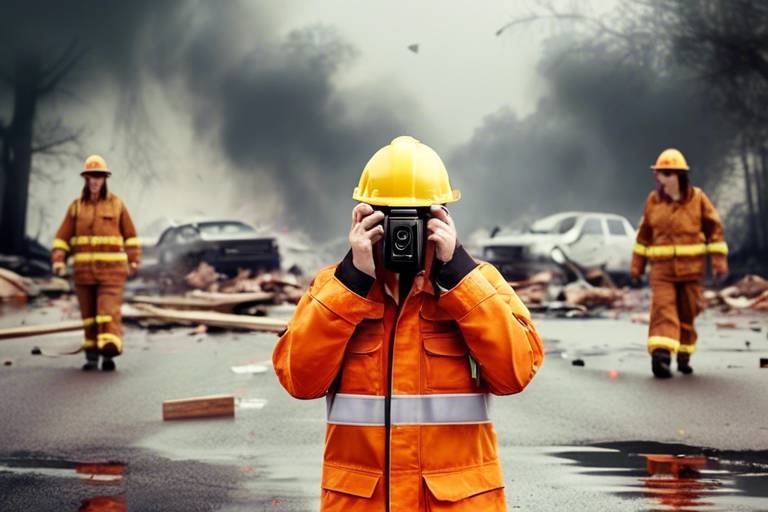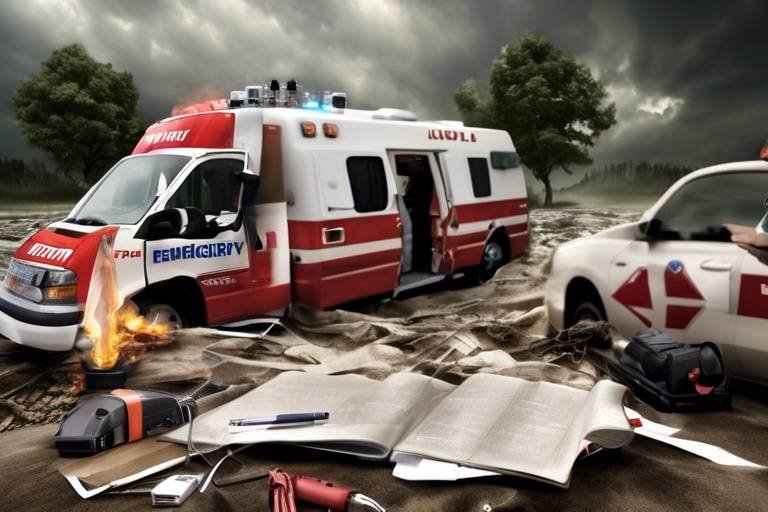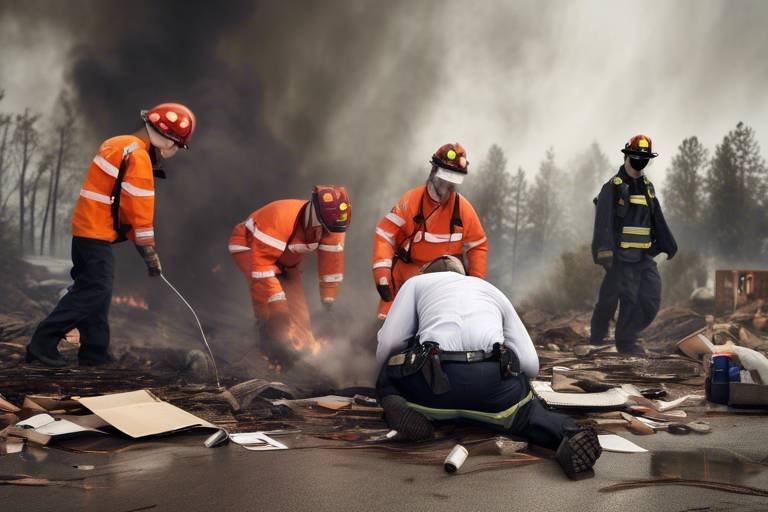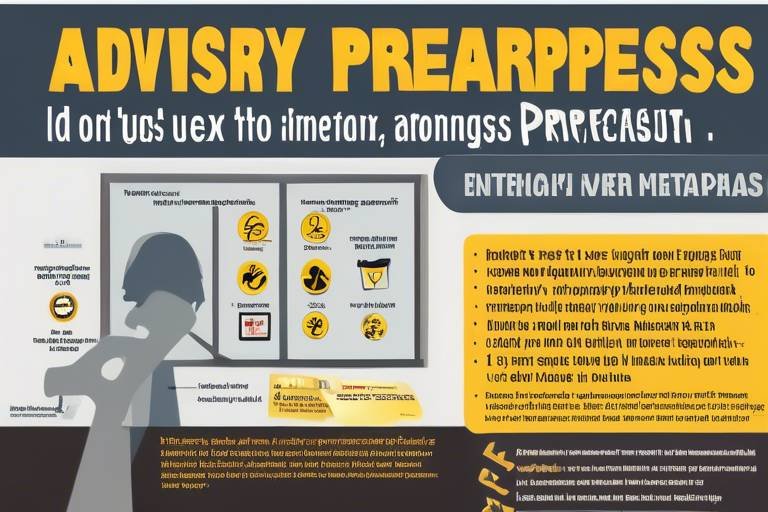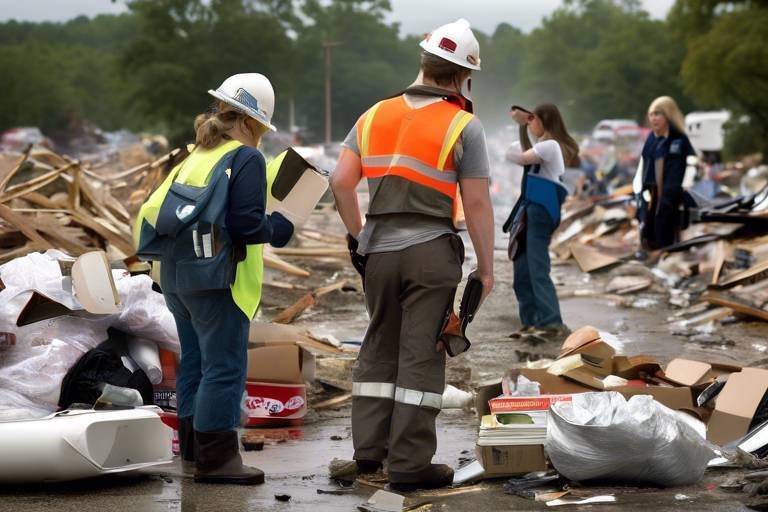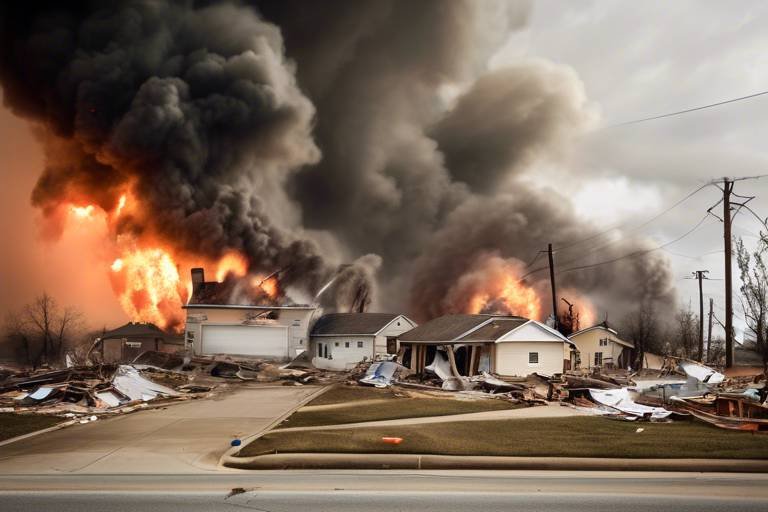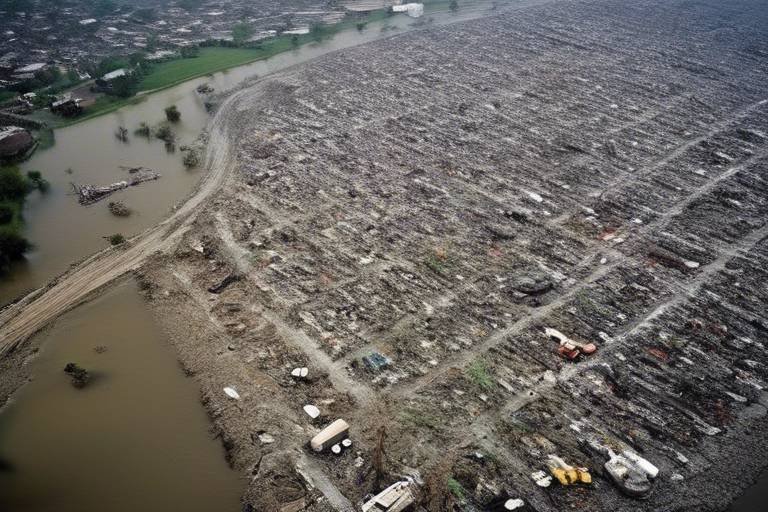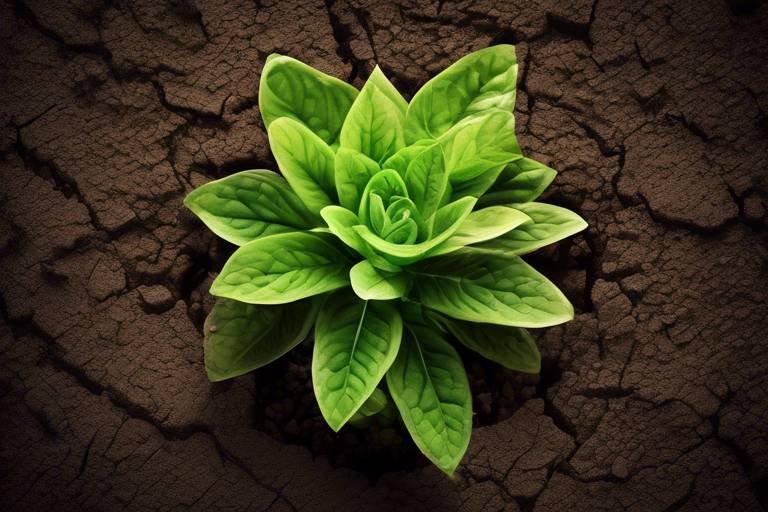Utilizing Mobile Applications for Emergency Preparedness
In today’s fast-paced world, the unexpected can happen at any moment. Whether it’s a natural disaster, a public health crisis, or even a personal emergency, being prepared is crucial. This is where mobile applications come into play. They serve as invaluable tools that can significantly enhance our readiness for emergencies. Imagine having a lifeline right in your pocket—an app that not only alerts you about impending dangers but also equips you with the knowledge and resources to respond effectively. With the right mobile applications, you can transform yourself from a passive observer into an active participant in your own safety and that of your community.
Mobile apps have revolutionized the way we approach emergency preparedness. They offer a range of features designed to keep us informed and ready. From real-time alerts to comprehensive resource guides, these applications are tailored to meet the needs of individuals and communities alike. The best part? They are accessible to almost anyone with a smartphone, making emergency preparedness a collective effort that can unite neighborhoods and cities. So, let’s dive deeper into how these applications can empower us to face emergencies head-on, ensuring we’re not just waiting for help, but actively preparing for it.
Mobile applications play a crucial role in emergency preparedness by offering real-time information, resources, and communication tools to help users stay informed and ready for any crisis. Think of them as your personal emergency management team, available 24/7. These apps provide a direct line to critical updates, allowing you to monitor situations as they unfold. When a storm is brewing or an evacuation is necessary, the last thing you want is to be caught off guard. With the right app, you can receive instant notifications about weather warnings, road closures, and safety instructions, ensuring you’re always in the loop.
So, what makes an emergency preparedness app effective? It’s not just about flashy graphics or a user-friendly interface; it’s about the features that truly matter in a crisis. Effective emergency preparedness apps include:
- Alerts: Real-time notifications about emergencies in your area.
- Emergency Contacts: Quick access to family, friends, and local authorities.
- Resource Guides: Information on supplies, safety measures, and emergency plans.
- Interactive Maps: Visual aids to help you navigate to safety.
These features work together to provide comprehensive support during emergencies, ensuring that you have everything you need right at your fingertips.
One of the standout features of emergency preparedness apps is the ability to receive real-time alerts and notifications. These alerts keep users informed about potential threats, enabling them to take timely actions to ensure their safety and preparedness in emergencies. Imagine receiving a notification on your phone just moments before a severe weather event strikes your area. This kind of timely information can make all the difference between being caught off guard and being prepared to take action.
What’s even better? Many apps offer customizable alert settings. This means you can tailor notifications based on your location and specific interests. Whether you want updates on local wildfires, floods, or even health emergencies, you can choose what’s most relevant to you. This personalization ensures that you’re not overwhelmed with unnecessary information but are still kept in the loop about the threats that matter most.
Integration with local services enhances the functionality of emergency apps, providing users with access to nearby shelters, hospitals, and emergency responders when needed. Imagine being able to find the nearest safe zone or medical facility with just a few taps on your phone. This feature can save precious time during a crisis, allowing you to focus on what’s truly important—keeping yourself and your loved ones safe.
Resource guides and checklists within apps help users prepare for emergencies by providing essential information on supplies, safety measures, and emergency plans. Having a well-thought-out plan can be the difference between chaos and calm when disaster strikes. These checklists can guide you on what to pack, how to secure your home, and even how to communicate with your family in case of separation. It’s like having a personal coach cheering you on and ensuring you’re ready for anything.
Mobile apps facilitate community engagement by connecting users with local organizations, volunteer opportunities, and shared resources to foster collective preparedness efforts. When we come together as a community, we become stronger. These apps can help you find local initiatives that promote emergency preparedness, allowing you to join forces with your neighbors and make a bigger impact.
Connecting with local emergency services through mobile apps enables users to receive updates and assistance directly from authorities during a crisis. This direct line of communication can be vital in ensuring that you have accurate and timely information when it matters most. Plus, it builds trust between the community and local services, creating a more prepared and resilient environment.
Finally, sharing information and resources within the app fosters a sense of community, encouraging users to collaborate and support each other in emergency preparedness initiatives. Whether it’s sharing tips on how to create an emergency kit or organizing a neighborhood watch, these apps empower users to take collective action. After all, in a crisis, it’s not just about individual preparedness; it’s about coming together to ensure the safety and well-being of everyone.
Q: How can I find the best emergency preparedness apps?
A: Look for apps with high ratings, positive user reviews, and features that suit your specific needs. Consider trying a few to see which interface you prefer.
Q: Are emergency preparedness apps free?
A: Many emergency preparedness apps are free, but some may offer premium features for a fee. Always check the app description for pricing details.
Q: Can I use these apps offline?
A: Some apps offer offline capabilities, allowing you to access important information even without an internet connection. Check the app’s features to see if this is available.

The Role of Mobile Apps in Emergency Preparedness
In today’s fast-paced world, being prepared for emergencies is not just a luxury; it’s a necessity. Mobile applications have emerged as powerful tools that can significantly enhance our ability to respond to various crises. Imagine having crucial information and resources right at your fingertips during a natural disaster or a public health emergency. That’s the magic of mobile apps! They serve as a lifeline, providing real-time data, communication channels, and essential resources that empower individuals and communities to act swiftly and effectively.
One of the most compelling aspects of these apps is their capacity to deliver real-time information. Whether it’s a weather alert, a public safety notification, or updates from local authorities, these applications keep users informed about potential threats. This immediate access to information can make all the difference when seconds count. For example, during a severe storm, an app can notify users of evacuation routes or shelter locations, allowing them to make informed decisions quickly.
Moreover, mobile apps are designed to be user-friendly and accessible. They often feature intuitive interfaces that make navigation simple, even for those who may not be tech-savvy. This accessibility is crucial in emergencies when stress levels are high, and clear communication is vital. Users can easily find the information they need, whether it’s a checklist for emergency supplies or a guide on how to respond to specific types of disasters.
Another significant advantage of mobile apps in emergency preparedness is their ability to facilitate communication. In times of crisis, staying connected with family, friends, and local authorities is essential. Many apps include features that allow users to share their status, check in with loved ones, and receive updates from emergency services. This communal aspect not only enhances individual preparedness but also fosters a sense of community, encouraging users to support one another during challenging times.
Furthermore, mobile applications often come equipped with practical tools such as interactive maps that display real-time data on hazards, resources, and safe zones. This functionality is particularly beneficial during large-scale emergencies where traditional communication methods may falter. Users can view the locations of shelters, hospitals, and emergency responders, helping them navigate through chaos with greater confidence and clarity.
In summary, mobile apps play a pivotal role in emergency preparedness by providing essential information, facilitating communication, and offering practical tools that empower individuals and communities. As we continue to face various challenges, embracing these technological advancements can significantly enhance our collective ability to respond effectively to emergencies.

Features of Effective Emergency Preparedness Apps
In today's fast-paced world, where emergencies can strike at any moment, having a reliable emergency preparedness app on your smartphone is not just a luxury—it's a necessity. These applications are designed to equip users with the tools and information they need to respond effectively to various crises. But what exactly makes an emergency preparedness app effective? Let’s dive into the essential features that can transform a simple app into a lifesaver.
First and foremost, real-time alerts and notifications stand out as one of the most critical features. Imagine receiving an instant notification about a severe weather warning, allowing you to take immediate action. These alerts can be life-changing, providing timely information about potential threats in your area. Users can often customize these alerts based on their preferences and geographical location. This means you won't be bombarded with irrelevant information; instead, you'll receive tailored updates that matter to you.
Real-time alerts are not just about warnings; they also encompass various notifications that guide users during emergencies. Whether it's a fire evacuation order or a sudden road closure due to flooding, having immediate access to this information can significantly reduce panic and confusion. The best apps ensure that these notifications are not only timely but also actionable, offering clear steps to follow in response to the alert.
One of the standout features of effective emergency preparedness apps is their customizable alert settings. Users can fine-tune their notifications based on specific interests, such as weather updates, local emergencies, or public health alerts. This personalization ensures that you are only receiving information pertinent to your situation, making it easier to stay focused and informed. For instance, if you live in a hurricane-prone area, you can choose to receive alerts specifically related to tropical storms and hurricanes, while ignoring other types of notifications.
Another essential feature is the integration with local services. This functionality connects users with nearby shelters, hospitals, and emergency responders. In a crisis, knowing where to go for assistance can be crucial. Some apps even provide interactive maps that guide users to the nearest safe locations, making it easier to navigate during stressful situations. By leveraging GPS technology, these apps can direct users to resources that might otherwise be difficult to find.
Additionally, effective emergency preparedness apps often include resource guides and checklists. These features help users prepare well in advance of any potential emergency. Imagine having a digital checklist that reminds you to stock up on essentials like water, non-perishable food, and first-aid supplies. Such guides can also offer safety measures specific to different types of emergencies, whether it's a natural disaster, a fire, or a public health crisis. By having this information at your fingertips, you can create a comprehensive emergency plan tailored to your needs.
Resource guides can be particularly useful for educating users about the steps they should take before, during, and after an emergency. For example, a good app might provide a checklist that includes:
- Emergency contact numbers
- Evacuation routes
- First aid instructions
- Supplies needed for sheltering in place
These guides can serve as a valuable reference in a time of crisis, ensuring that users remain calm and collected while navigating through challenging situations.
In summary, effective emergency preparedness apps are characterized by their ability to provide real-time alerts, customizable settings, integration with local services, and comprehensive resource guides. By incorporating these features, these apps empower individuals and communities to respond effectively to emergencies, ultimately enhancing overall safety and preparedness.
1. What types of emergencies can these apps help with?
Most emergency preparedness apps are designed to assist users with a wide range of emergencies, including natural disasters (like hurricanes and earthquakes), public health crises, and local emergencies (such as fires or chemical spills).
2. Are these apps free to use?
Many emergency preparedness apps are available for free, but some may offer premium features that require a subscription or one-time payment. Always check the app's details before downloading.
3. Can I customize the alerts I receive?
Yes! Most effective emergency preparedness apps allow users to customize their alert settings based on location and specific interests, ensuring that you receive relevant notifications.
4. How do I know if the information is reliable?
Reputable emergency preparedness apps often source their information from trusted organizations, such as government agencies and local emergency services. Always look for apps that have positive reviews and are backed by credible sources.

Real-Time Alerts and Notifications
In today's fast-paced world, being prepared for emergencies is more crucial than ever. This is where come into play. Imagine receiving a timely notification on your phone about a severe weather warning or an unexpected natural disaster in your area. This feature can be the difference between chaos and calm, enabling you to take immediate action to protect yourself and your loved ones.
Real-time alerts provide users with up-to-the-minute information about various emergencies, including natural disasters like hurricanes, floods, and earthquakes, as well as human-made crises such as chemical spills or terrorist threats. These notifications can come from a variety of sources, including local government agencies, weather services, and even community organizations. The key here is that they keep you informed when it matters most, allowing you to make quick decisions that could save lives.
One of the standout features of these alerts is their customizability. Users can often tailor their notification settings based on their location and personal interests. For instance, if you live in a flood-prone area, you can set alerts specifically for flood warnings. This level of customization ensures that you’re not overwhelmed with irrelevant information but instead receive only what you need to know. It’s like having a personal assistant who knows exactly what to keep an eye on for you!
Moreover, many emergency preparedness apps integrate seamlessly with local services, enhancing the effectiveness of real-time alerts. For example, if a tornado warning is issued, the app might not only notify you but also provide directions to the nearest shelter, contact information for emergency responders, and even a checklist of items to bring. This integration transforms a simple alert into a comprehensive survival tool, equipping you with everything you need to stay safe.
To give you a clearer picture, here’s a quick overview of the types of real-time alerts you might receive through an emergency preparedness app:
| Type of Alert | Description |
|---|---|
| Weather Alerts | Notifications about severe weather conditions like storms, floods, or heatwaves. |
| Emergency Alerts | Alerts about local emergencies such as evacuations, chemical spills, or public safety threats. |
| Health Alerts | Information about health emergencies, including disease outbreaks or public health warnings. |
In conclusion, the power of real-time alerts and notifications cannot be overstated. They empower individuals and communities to respond effectively to emergencies, ensuring that everyone has the information they need to stay safe. By leveraging technology, we can transform how we prepare for and react to crises, making our lives a little less unpredictable and a lot more secure.
- How can I customize my alerts? Most emergency preparedness apps allow you to set preferences based on your location and the types of emergencies you want to be alerted about.
- What sources provide these alerts? Alerts can come from local government agencies, weather services, and community organizations, ensuring you receive accurate and timely information.
- Can I receive alerts if I’m traveling? Yes, many apps can track your location and provide alerts based on where you are, even if you’re away from home.

Customizable Alert Settings
In the realm of emergency preparedness, staying informed is paramount. This is where in mobile applications come into play. Imagine having the power to tailor notifications specifically to your needs and preferences, ensuring that you receive the most relevant information right when you need it. It's like having a personal assistant dedicated to your safety, filtering out the noise and delivering only what matters most.
These settings allow users to adjust alerts based on various factors, including their location, the type of emergency, and even personal interests. For instance, if you're particularly concerned about severe weather, you can opt to receive alerts specifically for tornadoes, hurricanes, or floods. This level of customization not only enhances your awareness but also empowers you to take timely actions that could potentially save lives.
Moreover, many apps provide options to set notification preferences, such as:
- Sound Alerts: Choose different sounds for different types of alerts, so you know what to expect when your phone buzzes.
- Vibration Settings: Opt for a silent mode with vibrations, perfect for situations where sound is not an option.
- Frequency of Notifications: Customize how often you want to receive updates, ensuring that you’re not overwhelmed with information.
Additionally, some applications even offer a feature that allows users to share their alert settings with family members or friends. This can be incredibly beneficial during a crisis, as it ensures that everyone in your circle is on the same page and prepared for any situation. Imagine being able to coordinate with loved ones during an emergency, all thanks to the customizable features of your app.
In short, customizable alert settings are a game-changer in emergency preparedness applications. They not only provide essential information but also enhance the user experience by allowing individuals to tailor notifications to their specific needs. This level of personalization ensures that users remain engaged and informed, making it easier to respond effectively during emergencies. Just like a well-tuned instrument, these settings harmonize the flow of information, allowing you to strike the right chord when it matters most.
Q1: How do I customize my alert settings in emergency preparedness apps?
A1: Most apps have a settings menu where you can choose your preferred notification types, sounds, and frequencies. Explore the app to find the 'Notifications' or 'Alerts' section to make your adjustments.
Q2: Can I receive alerts for multiple types of emergencies?
A2: Yes! Many apps allow you to select various emergency types, ensuring you stay informed about what matters to you, whether it’s weather alerts, health emergencies, or local incidents.
Q3: Will I be notified if I travel to a different location?
A3: Many apps use your device's GPS to provide location-specific alerts. If you travel to a different area, make sure your location settings are enabled for real-time notifications relevant to your new surroundings.
Q4: Are customizable alert settings available in all emergency preparedness apps?
A4: While many popular apps offer customizable alert settings, it's best to check the app's features before downloading to ensure it meets your specific needs.

Integration with Local Services
This article explores how mobile applications can enhance emergency preparedness, providing tools and resources for individuals and communities to effectively respond to various emergencies and disasters.
Mobile applications play a crucial role in emergency preparedness by offering real-time information, resources, and communication tools to help users stay informed and ready for any crisis.
Effective emergency preparedness apps include features such as alerts, emergency contacts, resource guides, and interactive maps to provide comprehensive support during emergencies.
Real-time alerts and notifications keep users informed about potential threats, enabling them to take timely actions to ensure their safety and preparedness in emergencies.
Customizable alert settings allow users to tailor notifications based on their location and specific interests, ensuring they receive relevant information during emergencies.
Integrating mobile applications with local services is a game-changer in emergency preparedness. Imagine having the power of your local community’s resources right at your fingertips! This integration allows users to access crucial information about nearby shelters, hospitals, and emergency responders. When disaster strikes, every second counts, and knowing where to go or who to call can make all the difference.
For instance, during a natural disaster like a hurricane or an earthquake, users can quickly find the nearest evacuation routes and shelters through their apps. Some apps even provide live updates on the status of these services, ensuring that users are not left in the dark. Furthermore, by integrating with local emergency services, apps can send alerts about road closures, weather updates, and safety tips directly from authorities. This means that users are not just passive recipients of information; they become active participants in their safety.
Additionally, many emergency preparedness apps offer features that allow users to:
- Locate nearby hospitals and clinics with real-time wait times.
- Connect with local volunteer organizations for support and resources.
- Access emergency hotlines and contact information for local services.
This seamless connection between users and local services fosters a sense of community and enhances collective preparedness efforts. By being informed and connected, individuals can not only protect themselves but also help others in their community during times of crisis.
Mobile apps facilitate community engagement by connecting users with local organizations, volunteer opportunities, and shared resources to foster collective preparedness efforts.
Connecting with local emergency services through mobile apps enables users to receive updates and assistance directly from authorities during a crisis.
Sharing information and resources within the app fosters a sense of community, encouraging users to collaborate and support each other in emergency preparedness initiatives.
Q1: How can I find the best emergency preparedness app for my needs?
A1: Look for apps with features that suit your specific requirements, such as real-time alerts, local service integration, and resource guides. Reading user reviews and checking ratings can also help you make an informed choice.
Q2: Are emergency preparedness apps free to use?
A2: Many emergency preparedness apps are free, but some may offer premium features for a fee. It's best to check the app details in the app store before downloading.
Q3: Can I rely solely on mobile apps for emergency preparedness?
A3: While mobile apps are valuable tools, they should complement other preparedness strategies. Always have a physical emergency kit and a communication plan in place.

Resource Guides and Checklists
When the unexpected strikes, having a solid plan can make all the difference. This is where come into play, acting as your trusty roadmap to safety. Imagine you're preparing for a storm; the last thing you want is to be scrambling for supplies or unsure of what to do. Effective emergency preparedness apps often include comprehensive resource guides that outline essential items you should have on hand, as well as safety measures tailored to specific emergencies. These guides not only provide a list of necessary supplies but also offer tips on how to use them effectively. For instance, a guide might suggest keeping a first-aid kit, flashlight, and non-perishable food in your emergency kit, along with instructions on how to administer basic first aid.
Checklists are another invaluable tool within these apps, allowing users to track their preparedness progress. By checking off items as you gather them, you can visually confirm that you're ready for whatever may come your way. Think of it as a treasure hunt, where each item you collect brings you one step closer to being fully prepared. Many apps allow users to customize their checklists based on personal needs and local risks, ensuring that everyone has a tailored approach to their emergency preparedness. For example, if you live in an area prone to earthquakes, your checklist might include items like sturdy shoes and a whistle, which are crucial for navigating debris.
Moreover, these resource guides often extend beyond just physical supplies. They may include links to local emergency services, evacuation routes, and contact information for nearby shelters. In times of crisis, knowing where to go and who to call can save precious minutes. Some apps even integrate interactive maps that highlight safe zones and emergency facilities, providing users with a visual aid that can be crucial in high-stress situations. This feature can be particularly beneficial during large-scale disasters, where every second counts.
In addition to individual preparedness, these resources foster a sense of community. Users can share their own tips and resources within the app, creating a collaborative environment where everyone can contribute to collective safety. Think of it as a neighborhood watch, but for emergency preparedness. By pooling knowledge and resources, communities can become stronger and more resilient in the face of disasters.
| Item | Quantity | Notes |
|---|---|---|
| Water | 1 gallon per person per day | For at least 3 days |
| Non-perishable food | 3-day supply | Canned goods, energy bars, etc. |
| First-aid kit | 1 | Include personal medications |
| Flashlight | 1 per person | With extra batteries |
| Whistle | 1 | To signal for help |
In conclusion, resource guides and checklists are not just features of emergency preparedness apps; they are lifelines that empower individuals and communities to act swiftly and effectively during crises. By equipping yourself with the right tools and information, you can transform uncertainty into confidence, ensuring that you and your loved ones are ready to face any challenge that comes your way.
Q: How often should I update my emergency preparedness checklist?
A: It's a good practice to review and update your checklist at least once a year or whenever there are significant changes in your household or local emergency services.
Q: Can I share my checklist with others?
A: Yes! Many emergency preparedness apps allow you to share your checklists and resources with friends and family to encourage collective preparedness.
Q: What should I do if I have special needs or medical conditions?
A: Customize your resource guides and checklists to include necessary medical supplies, medications, and any special considerations based on your needs.

Community Engagement through Mobile Apps
In today's fast-paced world, community engagement is more crucial than ever, especially when it comes to emergency preparedness. Mobile applications serve as a bridge, connecting individuals with local organizations and resources that can make a significant difference during crises. Imagine a scenario where a natural disaster strikes your area. How would you know where to find shelter or the nearest hospital? This is where mobile apps come into play, providing not just information but also fostering a sense of community among users.
These apps are designed to facilitate communication between individuals and local emergency services, creating a network of support that can be activated in times of need. For instance, many emergency preparedness apps allow users to receive real-time updates from local authorities, ensuring they are informed about evacuation routes, shelter locations, and safety measures. This integration with local services is a game-changer, as it empowers users to make informed decisions quickly.
Moreover, these applications often include features that encourage users to connect with each other. By sharing information and resources, users can collaborate on preparedness initiatives, fostering a stronger sense of community. For example, an app may include a section where users can post about volunteer opportunities, share tips on emergency kits, or even coordinate group drills. This kind of engagement not only prepares individuals but also strengthens the community as a whole.
To illustrate the impact of community engagement through mobile apps, consider the following table that highlights some of the key features:
| Feature | Description |
|---|---|
| Local Alerts | Receive notifications about emergencies from local authorities. |
| Resource Sharing | Users can share supplies, information, and volunteer opportunities. |
| Community Forums | Discussion boards for users to exchange ideas and strategies. |
| Emergency Contacts | Quick access to local emergency services and contacts. |
In essence, mobile apps not only serve as a tool for individual preparedness but also as a platform for community engagement. They enable users to collaborate effectively, share vital information, and support one another in times of crisis. Think of them as a digital neighborhood watch—keeping everyone informed and ready to act when it matters most.
- What types of emergencies can mobile apps help prepare for? Mobile apps can assist in preparing for various emergencies, including natural disasters like hurricanes and earthquakes, public health crises, and other local emergencies.
- Are there specific apps recommended for community engagement? Yes, there are several apps designed specifically for community engagement in emergency preparedness, such as "Nextdoor," "Citizen," and various local government apps.
- How can I ensure I receive alerts from these apps? Most apps allow you to customize your alert settings based on your location and preferences. Make sure to enable notifications and set your preferences to receive timely updates.
- Can I use these apps to volunteer during emergencies? Absolutely! Many apps have features that connect users with local volunteer opportunities, allowing you to contribute to your community during a crisis.

Connecting with Local Emergency Services
When disaster strikes, the importance of being connected to local emergency services cannot be overstated. Mobile applications are revolutionizing the way we interact with these vital resources, ensuring that help is just a tap away. Imagine being in the midst of a crisis, and instead of frantically searching for phone numbers or addresses, you can access everything you need through a single app. This is not just convenience; it’s a lifeline.
Many emergency preparedness apps now feature direct connections to local emergency services, allowing users to receive real-time updates and alerts. For instance, when a natural disaster occurs, such as a hurricane or wildfire, these apps can push notifications directly from local authorities. This means you’re not only informed about the situation but also about the steps you should take to stay safe. Isn’t that a game-changer?
Moreover, these applications often provide detailed information about local shelters, hospitals, and emergency responders. Users can quickly find the nearest shelter in case they need to evacuate, or locate a hospital if someone requires immediate medical attention. Here’s a quick look at some of the key features that enhance this connectivity:
| Feature | Description |
|---|---|
| Real-Time Updates | Receive alerts and notifications from local authorities about ongoing emergencies. |
| Location-Based Services | Find nearby shelters and hospitals based on your current location. |
| Direct Communication | Contact emergency services directly through the app in case of an emergency. |
Additionally, many apps allow users to customize their settings to receive information that is most relevant to them. For example, if you live in an area prone to flooding, you can set alerts specifically for flood warnings. This level of personalization ensures that you’re not overwhelmed with notifications that don’t pertain to your situation, allowing you to focus on what truly matters: your safety and the safety of your loved ones.
Furthermore, the integration of social media features within these apps can help spread crucial information quickly. Users can share alerts and updates with their friends and family, creating a network of informed individuals ready to respond. In a world where every second counts, this capability can make all the difference.
In summary, connecting with local emergency services through mobile applications transforms how individuals and communities prepare for and respond to emergencies. It provides a seamless way to stay informed, receive help, and share resources, ultimately enhancing our collective resilience. So, the next time you think about emergency preparedness, remember that your smartphone can be your most powerful tool.
- How do I find emergency services in my area using an app? Most emergency preparedness apps have a feature that uses your location to show nearby emergency services, shelters, and hospitals.
- Can I customize alerts for specific emergencies? Yes! Many apps allow you to set preferences for the types of alerts you want to receive based on your location and interests.
- Are these apps free to download? Most emergency preparedness apps are free, but some may offer premium features for a fee.
- What should I do if I can’t access the app during an emergency? It’s always a good idea to have backup communication methods, such as a battery-operated radio or a list of important phone numbers written down.

Sharing Information and Resources
In today's fast-paced world, the ability to share information and resources during emergencies is absolutely vital. Mobile applications serve as a bridge, connecting individuals with their communities and enabling them to exchange crucial information quickly and efficiently. Imagine being in the middle of a crisis, and instead of feeling isolated and helpless, you can reach out to your neighbors, local organizations, and emergency services with just a few taps on your smartphone. This is the power of mobile apps in enhancing community resilience.
One of the most significant advantages of these applications is their ability to create a collaborative environment. Users can share updates, safety tips, and even resources like food and shelter availability. For instance, if someone has extra supplies or is willing to open their home to those in need, they can post this information in the app, allowing others to respond quickly. This kind of community-driven support can make all the difference in a crisis, turning fear into action and isolation into solidarity.
Moreover, many emergency preparedness apps come equipped with features that allow users to create and share resource lists. These lists can include everything from local food banks to shelters and medical facilities. By having this information readily available, users can make informed decisions about where to go or whom to contact during an emergency. Additionally, some apps even allow for real-time updates, meaning that if a shelter reaches capacity or a food bank runs low on supplies, the information can be updated instantly for all users to see.
Furthermore, the ability to share personal experiences can be incredibly valuable. Users can post about what worked for them during past emergencies, such as effective communication strategies or successful evacuation plans. This shared knowledge not only empowers others but also fosters a sense of community as people come together to learn from one another. When individuals feel supported and informed, they are more likely to take proactive steps in their emergency preparedness efforts.
To illustrate this point, consider the following table that highlights some key features of mobile apps that facilitate the sharing of information and resources:
| Feature | Description |
|---|---|
| Community Bulletin Board | A space for users to post real-time updates, offers of assistance, and requests for help. |
| Resource Sharing | Allows users to share lists of available resources, such as food, shelter, and medical supplies. |
| Experience Sharing | Users can share personal stories and tips from past emergencies to help others prepare. |
| Emergency Contact List | A feature that allows users to quickly share their emergency contacts with others in the community. |
In conclusion, the ability to share information and resources through mobile applications not only enhances individual preparedness but also strengthens community ties. As we navigate the uncertainties of life, having a reliable platform to turn to can make all the difference. So, the next time you think about emergency preparedness, remember that you’re not alone; your community is just a tap away, ready to support you in times of need.
- What types of emergencies can mobile apps help with? Mobile apps can assist with various emergencies, including natural disasters, health crises, and community safety issues.
- Are emergency preparedness apps free to use? Many emergency preparedness apps are free, but some may offer premium features for a fee.
- Can I customize the alerts I receive from these apps? Yes, most apps allow users to customize alerts based on their location and specific interests.
- How do these apps connect me with local services? Many apps integrate with local emergency services, providing users with real-time updates and information about nearby resources.
Frequently Asked Questions
- What are the benefits of using mobile applications for emergency preparedness?
Mobile applications provide real-time information, alerts, and resources that can significantly enhance your readiness for emergencies. They keep you informed about potential threats and offer guidance on safety measures, making it easier to respond effectively during a crisis.
- How do real-time alerts work in these apps?
Real-time alerts notify users about immediate threats based on their location. These notifications can include weather warnings, evacuation orders, or other critical updates. By staying informed, you can take timely actions to protect yourself and your loved ones.
- Can I customize the alerts I receive?
Absolutely! Most emergency preparedness apps allow you to tailor your alert settings. You can choose which types of alerts you want to receive and even filter them based on your specific location or interests, ensuring that the information you get is relevant and useful.
- What features should I look for in an emergency preparedness app?
Look for apps that offer a combination of real-time alerts, resource guides, checklists, and interactive maps. Integration with local services, such as shelters and hospitals, is also crucial, as it provides immediate access to help when you need it most.
- How can mobile apps help with community engagement during emergencies?
Mobile apps foster community engagement by connecting users with local organizations and volunteer opportunities. They create a platform for sharing information and resources, encouraging collaboration among community members to enhance overall preparedness.
- Can I connect with local emergency services through these apps?
Yes, many emergency preparedness apps allow you to connect directly with local emergency services. This feature provides users with updates and assistance from authorities during a crisis, ensuring that you have the support you need when it matters most.
- Are resource guides and checklists really helpful?
Definitely! Resource guides and checklists help you prepare for emergencies by outlining essential supplies, safety measures, and emergency plans. Having this information at your fingertips can make a significant difference in how you respond to a disaster.


